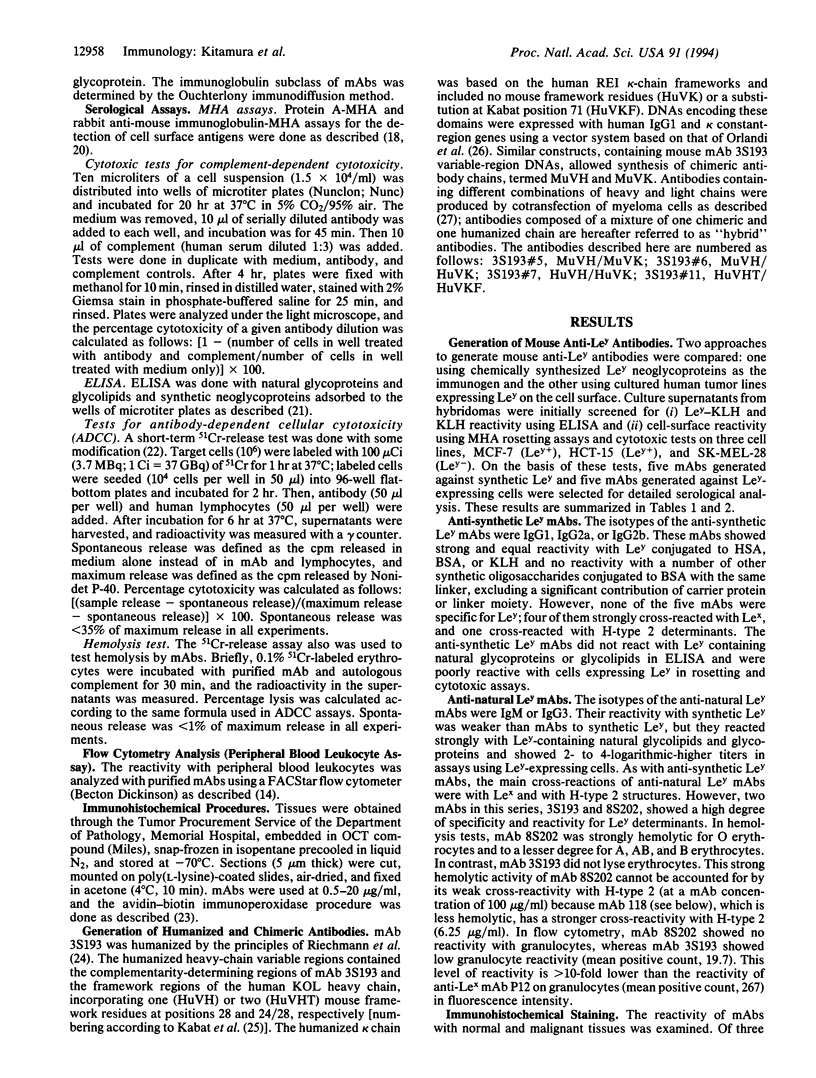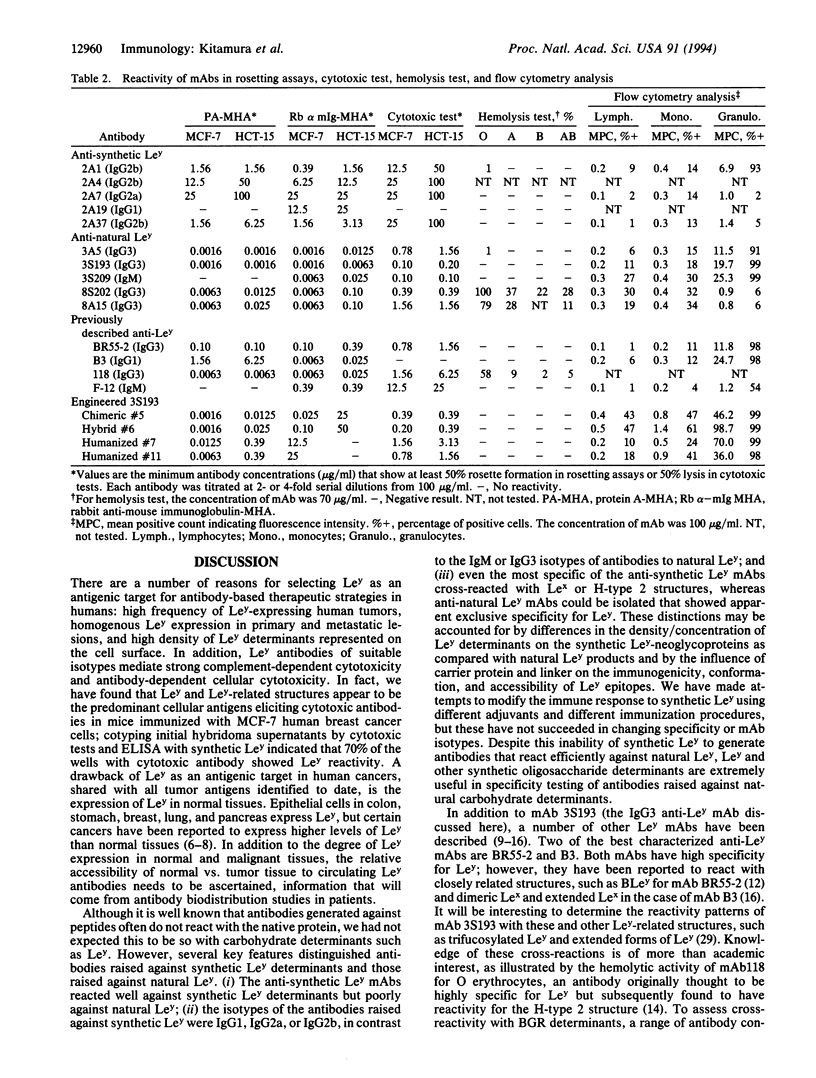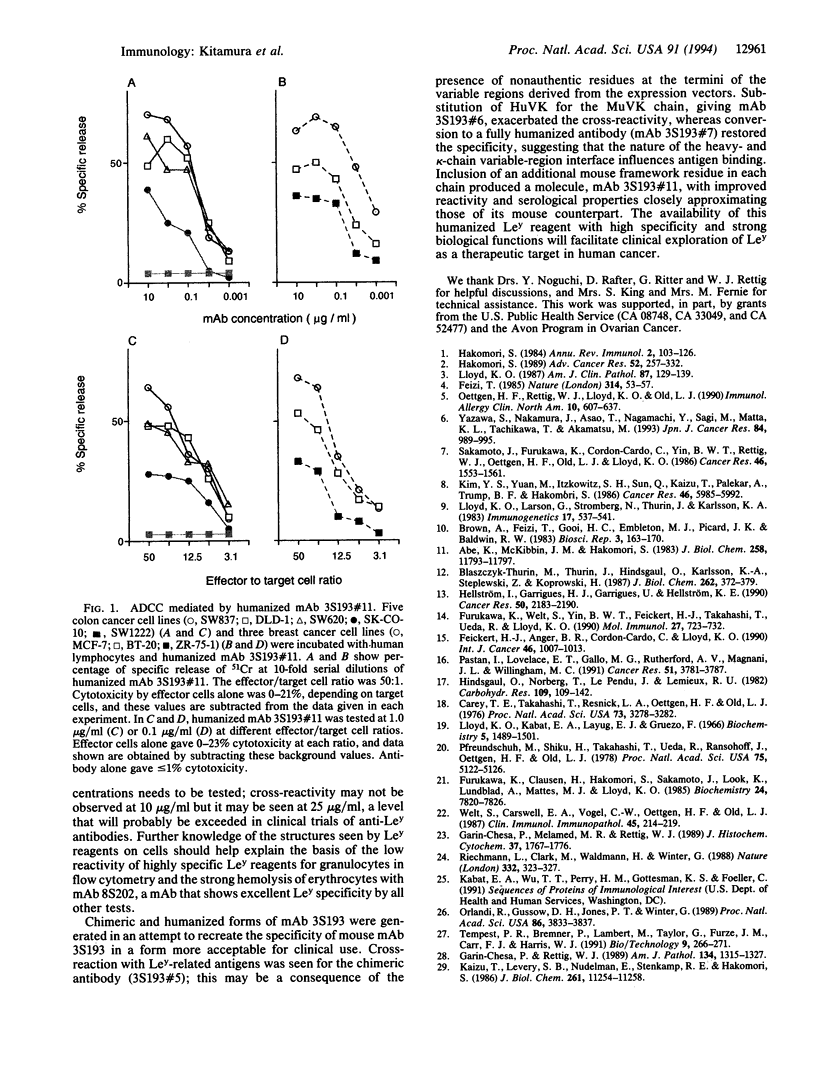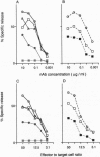Abstract
Le(y)-reactive monoclonal antibodies (mAbs) were generated in mice by immunization with synthetic Le(y) neoglycoproteins or with Le(y)-expressing cells. Serological analysis indicated that mAbs raised against synthetic Le(y) (i) reacted strongly with synthetic Le(y) but poorly with natural Le(y), (ii) cross-reacted with Le(x) or H-type 2 structures, and (iii) were IgG1, IgG2a, or IgG2b. mAbs raised against Le(y)-expressing cells (i) reacted with both synthetic Le(y) and natural Le(y), (ii) were of two types: cross-reactive with Le(x) or H-type 2 structures or specific for Le(y), and (iii) were IgM or IgG3. One of the mAbs raised against natural Le(y), mAb 3S193 (IgG3), showed high specificity for Le(y) in ELISA tests with synthetic Le(y) and Le(y) containing glycoproteins and glycolipids; it also reacted strongly in rosetting assays and cytotoxic tests with Le(y)-expressing cells. mAb 3S193 did not lyse O, A, AB, and B human erythrocytes in the presence of human complement. In flow cytometry, there was weak reactivity with granulocytes, a reactivity also observed with two previously described highly specific Le(y) mouse mAbs--BR55-2 (IgG3) and B3 (IgG1). A humanized version of mAb 3S193 has been constructed, and the specificity pattern and reactivity for Le(y) remain very similar to mouse mAb 3S193.
Full text
PDF




Images in this article
Selected References
These references are in PubMed. This may not be the complete list of references from this article.
- Abe K., McKibbin J. M., Hakomori S. The monoclonal antibody directed to difucosylated type 2 chain (Fuc alpha 1 leads to 2Gal beta 1 leads to 4[Fuc alpha 1 leads to 3]GlcNAc; Y Determinant). J Biol Chem. 1983 Oct 10;258(19):11793–11797. [PubMed] [Google Scholar]
- Blaszczyk-Thurin M., Thurin J., Hindsgaul O., Karlsson K. A., Steplewski Z., Koprowski H. Y and blood group B type 2 glycolipid antigens accumulate in a human gastric carcinoma cell line as detected by monoclonal antibody. Isolation and characterization by mass spectrometry and NMR spectroscopy. J Biol Chem. 1987 Jan 5;262(1):372–379. [PubMed] [Google Scholar]
- Brown A., Feizi T., Gooi H. C., Embleton M. J., Picard J. K., Baldwin R. W. A monoclonal antibody against human colonic adenoma recognizes difucosylated Type-2-blood-group chains. Biosci Rep. 1983 Feb;3(2):163–170. doi: 10.1007/BF01121947. [DOI] [PubMed] [Google Scholar]
- Carey T. E., Takahashi T., Resnick L. A., Oettgen H. F., Old L. J. Cell surface antigens of human malignant melanoma: mixed hemadsorption assays for humoral immunity to cultured autologous melanoma cells. Proc Natl Acad Sci U S A. 1976 Sep;73(9):3278–3282. doi: 10.1073/pnas.73.9.3278. [DOI] [PMC free article] [PubMed] [Google Scholar]
- Feickert H. J., Anger B. R., Cordon-Cardo C., Lloyd K. O. Cell-surface antigens of human lung tumors detected by mouse monoclonal antibodies: definition of blood-group- and non-blood-group-related antigenic systems. Int J Cancer. 1990 Dec 15;46(6):1007–1013. doi: 10.1002/ijc.2910460610. [DOI] [PubMed] [Google Scholar]
- Feizi T. Demonstration by monoclonal antibodies that carbohydrate structures of glycoproteins and glycolipids are onco-developmental antigens. Nature. 1985 Mar 7;314(6006):53–57. doi: 10.1038/314053a0. [DOI] [PubMed] [Google Scholar]
- Furukawa K., Clausen H., Hakomori S., Sakamoto J., Look K., Lundblad A., Mattes M. J., Lloyd K. O. Analysis of the specificity of five murine anti-blood group A monoclonal antibodies, including one that identifies type 3 and type 4 A determinants. Biochemistry. 1985 Dec 17;24(26):7820–7826. doi: 10.1021/bi00347a047. [DOI] [PubMed] [Google Scholar]
- Furukawa K., Welt S., Yin B. W., Feickert H. J., Takahashi T., Ueda R., Lloyd K. O. Analysis of the fine specificities of 11 mouse monoclonal antibodies reactive with type 2 blood group determinants. Mol Immunol. 1990 Aug;27(8):723–732. doi: 10.1016/0161-5890(90)90081-a. [DOI] [PubMed] [Google Scholar]
- Garin-Chesa P., Melamed M. R., Rettig W. J. Immunohistochemical analysis of human neuronectin expression in normal, reactive, and neoplastic tissues. J Histochem Cytochem. 1989 Dec;37(12):1767–1776. doi: 10.1177/37.12.2685107. [DOI] [PubMed] [Google Scholar]
- Garin-Chesa P., Rettig W. J. Immunohistochemical analysis of LNT, NeuAc2----3LNT, and Lex carbohydrate antigens in human tumors and normal tissues. Am J Pathol. 1989 Jun;134(6):1315–1327. [PMC free article] [PubMed] [Google Scholar]
- Hakomori S. Aberrant glycosylation in tumors and tumor-associated carbohydrate antigens. Adv Cancer Res. 1989;52:257–331. doi: 10.1016/s0065-230x(08)60215-8. [DOI] [PubMed] [Google Scholar]
- Hakomori S. Tumor-associated carbohydrate antigens. Annu Rev Immunol. 1984;2:103–126. doi: 10.1146/annurev.iy.02.040184.000535. [DOI] [PubMed] [Google Scholar]
- Hellström I., Garrigues H. J., Garrigues U., Hellström K. E. Highly tumor-reactive, internalizing, mouse monoclonal antibodies to Le(y)-related cell surface antigens. Cancer Res. 1990 Apr 1;50(7):2183–2190. [PubMed] [Google Scholar]
- Hindsgaul O., Norberg T., Le Pendu J., Lemieux R. U. Synthesis of type 2 human blood-group antigenic determinants. The H, X, and Y haptens and variations of the H type 2 determinant as probes for the combining site of the lectin I of Ulex europaeus. Carbohydr Res. 1982 Nov 1;109:109–142. doi: 10.1016/0008-6215(82)84034-2. [DOI] [PubMed] [Google Scholar]
- Kaizu T., Levery S. B., Nudelman E., Stenkamp R. E., Hakomori S. Novel fucolipids of human adenocarcinoma: monoclonal antibody specific for trifucosyl Ley (III3FucV3FucVI2FucnLc6) and a possible three-dimensional epitope structure. J Biol Chem. 1986 Aug 25;261(24):11254–11258. [PubMed] [Google Scholar]
- Kim Y. S., Yuan M., Itzkowitz S. H., Sun Q. B., Kaizu T., Palekar A., Trump B. F., Hakomori S. Expression of LeY and extended LeY blood group-related antigens in human malignant, premalignant, and nonmalignant colonic tissues. Cancer Res. 1986 Nov;46(11):5985–5992. [PubMed] [Google Scholar]
- Lloyd K. O., Kabat E. A., Layug E. J., Gruezo F. Immunochemical studies on blood groups. XXXIV. Structures of some oligosaccharides produced by alkaline degradation of blood group A, B, and H substances. Biochemistry. 1966 May;5(5):1489–1501. doi: 10.1021/bi00869a007. [DOI] [PubMed] [Google Scholar]
- Lloyd K. O., Larson G., Strömberg N., Thurin J., Karlsson K. A. Mouse monoclonal antibody F-3 recognizes the difucosyl type-2 blood group structure. Immunogenetics. 1983;17(5):537–541. doi: 10.1007/BF00696877. [DOI] [PubMed] [Google Scholar]
- Lloyd K. O. Philip Levine award lecture. Blood group antigens as markers for normal differentiation and malignant change in human tissues. Am J Clin Pathol. 1987 Jan;87(1):129–139. doi: 10.1093/ajcp/87.1.129. [DOI] [PubMed] [Google Scholar]
- Orlandi R., Güssow D. H., Jones P. T., Winter G. Cloning immunoglobulin variable domains for expression by the polymerase chain reaction. Proc Natl Acad Sci U S A. 1989 May;86(10):3833–3837. doi: 10.1073/pnas.86.10.3833. [DOI] [PMC free article] [PubMed] [Google Scholar]
- Pastan I., Lovelace E. T., Gallo M. G., Rutherford A. V., Magnani J. L., Willingham M. C. Characterization of monoclonal antibodies B1 and B3 that react with mucinous adenocarcinomas. Cancer Res. 1991 Jul 15;51(14):3781–3787. [PubMed] [Google Scholar]
- Pfreundschuh M., Shiku H., Takahashi T., Ueda R., Ransohoff J., Oettgen H. F., Old L. J. Serological analysis of cell surface antigens of malignant human brain tumors. Proc Natl Acad Sci U S A. 1978 Oct;75(10):5122–5126. doi: 10.1073/pnas.75.10.5122. [DOI] [PMC free article] [PubMed] [Google Scholar]
- Riechmann L., Clark M., Waldmann H., Winter G. Reshaping human antibodies for therapy. Nature. 1988 Mar 24;332(6162):323–327. doi: 10.1038/332323a0. [DOI] [PubMed] [Google Scholar]
- Sakamoto J., Furukawa K., Cordon-Cardo C., Yin B. W., Rettig W. J., Oettgen H. F., Old L. J., Lloyd K. O. Expression of Lewisa, Lewisb, X, and Y blood group antigens in human colonic tumors and normal tissue and in human tumor-derived cell lines. Cancer Res. 1986 Mar;46(3):1553–1561. [PubMed] [Google Scholar]
- Tempest P. R., Bremner P., Lambert M., Taylor G., Furze J. M., Carr F. J., Harris W. J. Reshaping a human monoclonal antibody to inhibit human respiratory syncytial virus infection in vivo. Biotechnology (N Y) 1991 Mar;9(3):266–271. doi: 10.1038/nbt0391-266. [DOI] [PubMed] [Google Scholar]
- Welt S., Carswell E. A., Vogel C. W., Oettgen H. F., Old L. J. Immune and nonimmune effector functions of IgG3 mouse monoclonal antibody R24 detecting the disialoganglioside GD3 on the surface of melanoma cells. Clin Immunol Immunopathol. 1987 Nov;45(2):214–229. doi: 10.1016/0090-1229(87)90036-5. [DOI] [PubMed] [Google Scholar]
- Yazawa S., Nakamura J., Asao T., Nagamachi Y., Sagi M., Matta K. L., Tachikawa T., Akamatsu M. Aberrant alpha 1-->2fucosyltransferases found in human colorectal carcinoma involved in the accumulation of Leb and Y antigens in colorectal tumors. Jpn J Cancer Res. 1993 Sep;84(9):989–995. doi: 10.1111/j.1349-7006.1993.tb00190.x. [DOI] [PMC free article] [PubMed] [Google Scholar]



